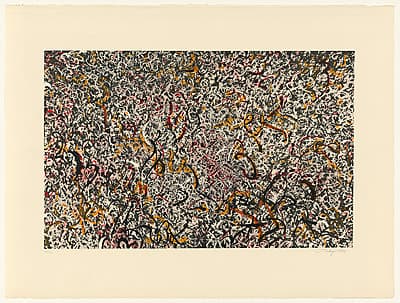
Mark
TOBEY
United States of America
1890
–
Switzerland
1976
October
1970
lithograph, printed in colour, from multiple stones/plates
68/200
pencil l.r. 'Tobey 1970' pencil l.l. 68/200
64.2 (h)
x 85.0 (w)
cm
Purchased 1986
National Gallery of Australia, Canberra
NGA 1986.1352
- with Galerie Beyeler, Basel;
- from whom bough by the Australian National Gallery, April 1986
- The Spontaneous Gesture
- National Gallery of Australia 06 Jun 1987 – 13 Sep 1987
- Abstract Expressionism: the National Gallery of Australia celebrates the centenaries of Jackson Pollock and Morris Louis
- 14 Jul 2012 – 24 Feb 2013
Mark Tobey became interested in printmaking after 1960 when he settled in Basel, Switzerland. The artist, who had traveled extensively in America, Europe and Asia, was drawn to the city and remained there for the rest of his life. The lithographs in the Gallery’s collection demonstrate Tobey’s distinctive ‘white writing’, the technique for which he was best known. On a foundation of abstract marks, he overlaid thousands of small and interwoven calligraphic symbols. The artist likened this microscopic web of interconnected brushstrokes to ‘chlorophyll in the veins of a leaf’.[1]
Tobey was very conscious of his place on the cusp of Eastern and Western tradition; his ideas about interconnectivity were closely related to his Bahai faith. He said, ‘It is better to feel a painting than to look at it.’ The illusion of flatness in these works gives way to sense of multi-layered depth. The pulsating lines—which extend in every direction and beyond the boundaries of the pictorial frame—are countered by a meditative energy. Tobey’s work is often compared to Pollock’s, and some accounts represent his work as the inspiration for paintings such as Blue poles. Certainly, the ‘all-over’ quality evident in Tobey’s lithographs has many similarities to Pollock’s approach, albeit in miniature.
Lucina Ward and Gadia Zrihan
[1]Mark Tobey: Retrospective exhibition, paintings and drawings, 1925–1961, London: Whitechapel Gallery 1962, p. 12
Discussion of the work
Mark Tobey became interested in printmaking after 1960 when he settled in Basel, Switzerland. The artist, who had traveled extensively in America, Europe and Asia, was drawn to the city and remained there for the rest of his life. The lithographs in the Gallery’s collection demonstrate Tobey’s distinctive ‘white writing’, the technique for which he was best known. On a foundation of abstract marks, he overlaid thousands of small and interwoven calligraphic symbols. The artist likened this microscopic web of interconnected brushstrokes to ‘chlorophyll in the veins of a leaf’.[1]
Tobey was very conscious of his place on the cusp of Eastern and Western tradition; his ideas about interconnectivity were closely related to his Bahai faith. He said, ‘It is better to feel a painting than to look at it.’ The illusion of flatness in these works gives way to sense of multi-layered depth. The pulsating lines—which extend in every direction and beyond the boundaries of the pictorial frame—are countered by a meditative energy. Tobey’s work is often compared to Pollock’s, and some accounts represent his work as the inspiration for paintings such as Blue poles. Certainly, the ‘all-over’ quality evident in Tobey’s lithographs has many similarities to Pollock’s approach, albeit in miniature.
Lucina Ward and Gadia Zrihan
[1]Mark Tobey: Retrospective exhibition, paintings and drawings, 1925–1961, London: Whitechapel Gallery 1962, p. 12
